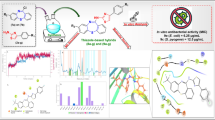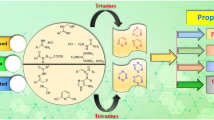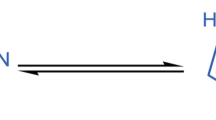Abstract
A facile and efficient method for the synthesis of novel derivatives of pefloxacin hydrazone via condensation of various aldehydes and pefloxacin acid hydrazide using conventional as well as solvent-free microwave irradiation methods was reported. The biological activity of these compounds was screened using array of techniques and found to exhibit promising broad spectrum of antibacterial activity against Gram-positive and Gram-negative bacteria, moderate antimycobacterial activity against Mycobacterium smegmatis and moderate antifungal activity opposed to Aspergillus clavatus and Candida albicans. Cytotoxic assay of the title compounds was evaluated against human Pc-3 cancer cell lines, and interestingly, very good anticancer properties were shown by the compounds. To explore the binding mode of the compounds and understand the key active site residues with Staphylococcus aureus DNA gyrase, a molecular docking study has been performed. The results of the docking studies of the reported derivatives were quite promising and manifested strong non-bonded interactions with DNA Gyrase.








Similar content being viewed by others
References
Aranha O, Wood DP Jr, Sarkar FH (2000) ciprofloxacin mediated cell growth inhibition, S/G2-M cell cycle arrest, and apoptosis in a human transitional cell carcinoma of the bladder cell line. Clin Cancer Res 6:891–900
Aranha O, Grignon R, Fernandes N, McDonnell TJ, Wood DP, Sarkar FH (2003) Suppression of human prostate cancer cell growth by ciprofloxacin is associated with cell cycle arrest and apoptosis. Int J Oncol 22:787–794
Badrinarayan P, Sastry GN (2011) Virtual high throughput screening in new lead identification. Comb Chem High Throughput Screen 14:840–860
Badrinarayan P, Sastry GN (2012) Virtual filters for the design of type II p38 MAP kinase inhibitors: a fragment based library generation approach. J Mol Graphics Model 34:89–100
Ball P (1994) Bacterial resistance to fluoroquinolones. Infection 22:140–147
Bax BD (2010) Type IIA topoisomerase inhibition by a new class of anti-bacterial agents. Nature 466:935–940
Bose DS, Idrees M, Jakka NM, Rao JV (2010) Diversity-oriented synthesis of quinolines via Friedlander annulation reaction under mild catalytic conditions. J Comb Chem 12:100–110
Bryskier A, Chantot JF (1995) Classification and structure-activity relationships of fluoroquinolones. Drugs 49:16–28
Chaturvedi V, Dwivedi N, Tripathi RP, Sinha S (2007) Evaluation of Mycobacterium smegmatis as a possible surrogate screen for selecting molecules active against multi-drug resistant Mycobacterium tuberculosis. J Gen Appl Microbiol 53:333–337
Cone R, Hasan SK, Lown JW, Morgan AR (1976) The mechanism of the degradation of DNA by streptonigrin. Can J Biochem 54:219–223
Cozzarelli NR (1980) Mechanistic studies of DNA replication and genetic recombination. Science 207:953
Debbia E, Schito GC, Niclletti G, Speciale A (1987) invitro activity of pefloxacin against gram-negative and gram-positive bacteria in comparison with other antibiotics. Chemioterapia 6:319–323
Dorr RT (1992) Bleomycin pharmacology: mechanism of action and resistance and clinical pharmacokinetics. Semin Oncol 19:3–8
Drlica K, Malik M (2003) Fluoroquinolones-action and resistance. Curr Top Med Chem 3:249–282
Drlica K, Zhao X (1997) DNA gyrase, topoisomerase IV, and the 4-quinolones. Microbiol Mol Biol Rev 61:377–392
Friesner RA, Banks JL, Murphy RB, Halgren TA, Klicic JJ, Mainz DT, Repasky MP, Knoll EH, Shelley M, Perry JK, Shaw DE, Francis P, Shenkin PS (2004) Glide: a new approach for rapid, accurate docking and scoring. Method and assessment of docking accuracy. J Med Chem 47:1739–1749
Friesner RA, Murphy RB, Repasky MP, Frye LL, Greenwood JR, Halgren TA, Sanschagrin PC, Mainz DT (2006) Extra precision glide: docking and scoring incorporating a model of hydrophobic enclosure for protein-ligand complexes. J Med Chem 49:6177–6196
Gould KA, Pan XS, Kerns RJ, Fisher LM (2004) Ciprofloxacin dimers target gyrase in Streptococcus pneumonia. Antimicrob Agents Chemother 48:2108–2115
Govinda rajulu G, Bojya Naik HS, Chran kumar G, Ramraj S, Sambashivam G, Poonimangadu KS (2014) New azetidine 3-carbonyl N-methyl-hydrazino derivatives of fluoroquinolones: synthesis and evaluation of antibacterial and anticancer properties. Med Chem Res 23:2856–2868
Hong CY, Kim YK, Lee YH, Kwak JH (1998) Methyloxime-substituted aminopyrrolidine a new surrogate for 7-basic group of quinoline. Bioorg Med Chem Lett 8:221–226
Ishiguro K, Takahashi YK, Sakiyama S, Arai T (1981) Binding of Saframycin A, a heterocyclic quinone anti-tumor antibiotic to DNA as revealed by the use of the antibiotic labeled with [14C] tyrosine or [14C] cyanide. J Biol Chem 256:2162
Iyer VN, Szybalski W (1964) Mitomycins and porfiromycin: chemical mechanism of activation and cross-linking of DNA. Science 145:55–58
Janardhan S, Sastry GN (2014) Dipeptidyl peptidase IV inhibitors: a new paradigm in type 2 diabetes treatment. Curr Drug Targets 15:600–621
Janardhan S, Srivani P, Sastry GN (2006a) 2D and 3D quantitative structure-activity relationship studies on a series of bis-pyridinium compounds as choline kinase inhibitors. QSAR Comb Sci 25:860–872
Janardhan S, Srivani P, Sastry GN (2006b) Choline kinase: an important target for cancer. Curr Med Chem 13:1169–1186
Janin YL (2007) Anti tuberculosis drugs: ten years of research. Bioorg Med Chem 15:2479–2513
Jones BM, Geary I, Lee ME, Duerden BI (1986) Activity of pefloxacin and thirteen other antimicrobial agents invitro against isolates from hospital and genitourinary infections. J Antimicrob Chemother 17:739–746
Lingaiah et al (2012) Synthesis of novel α-amino acid functionalized 6-fluoroquinolones, their anti-bacterial activity and molecular docking studies. Indian J Chem 51B:969–980
Mahadevi AS, Sastry GN (2013) Cation-π interaction: its role and relevevance in chemistry, biology, and material science. Chem Rev 113:2100–2138
Mamatha N, Suresh Babu N, Mukkanti K, Pal S (2011) 2-(6-Methoxynaphthalen-2-yl)propionic acid (1,3-dimethyl-butylidene)hydrazide. Molbank M741:1–4
Minotti G, Menna P, Salvatorelli E, Cairo G, Gianni L (2004) Anthracyclines: molecular advances and pharmacologic developments in antitumor activity and cardiotoxicity. Pharmacol Rev 56:185–229
Mosmann T (1983) Rapid colorimetric assay for cellular growth and survival: application to proliferation and cytotoxicity assays. J Immunol Methods 65:55–63
Mudassar A, Christopher H, Miller DS, Bellows RO (2010) Evaluation of the Mycobacterium smegmatis and BCG models for the discovery of Mycobacterium tuberculosis inhibitors. Tuberculosis 90:333–337
Navin B, Patel E, Sarvil D (2009) Synthesis and antimicrobial study of fluoroquinolone based 4-thiazolidinones. Med Chem Res. doi:10.1007/s00044-009-9228-2
Nayyar A, Jain A (2005) Recent advances in new structural classes of anti-tuberculosis agents. Curr Med Chem 12:1873–1886
Patel NB, Patel AL, Chauhan HI (2007) Synthesis of amide derivatives of quinoline and their antimicrobial studies. Indian J Chem 46B:126–134
Pfaller MA, Barry AL (1994) Evaluation of a novel colorimetric broth microdilution method for antifungal susceptibility testing of yeast isolates. J Clin Microbiol 32:1992–1996
Pigram WJ, Fuller W, Hamilton LD (1972) Stereochemistry of intercalation: interaction of daunomycin with DNA. Nat New Bio 235:17–19
Pinto AC, Moreira JN, Simoes S (2009) ciprofloxacin sensitizes hormone-refractory prostate cancer cell lines to doxorubicin and docetaxel treatment on a schedule-dependent manner. Cancer Chemother Pharmacol 64:445–454
Reddy AS, Pati SP, Kumar PP, Pradeep HN, Sastry GN (2006) Virtual screening in drug discovery: a computational perspective. Curr Protein Pept Sci 8:329–351
Reddy LV, Suman A, Beevi SS, Mangamoori LN, Mukkanti K, Pal S (2010) Design and synthesis of 1-aroyl-2-ylidene hydrazines under conventional and microwave irradiation conditions and their cytotoxic activities. J Braz Chem Soc 21:98–104
Satish S, Raveesha KA, Janardhna GR (2002) Antibacterial activity of plant extracts on phytopathogenic Xanthomonas campestris pathovars. Lett Appl Microbiol 22:145–147
Schmitz FJ, Verhoef J, Fluit AC (1999) Comparative activities of six different fluoroquinolones against 9,682 clinical bacterial isolates from 20 European university hospitals participating in the European SENTRY surveillance programme. Int J Antimicrob Agents 12:311–317
Senthil Kumar S, Kamaraj M (2010) Analysis of phytochemical constituents and antimicrobial activities of Cucumis anguri L. against clinical pathogens, American-Eurasian. J Agric Environ Sci 7:176–178
Senthilkumar P, Dinakaran M, Yogeeswari P, China A, Nagaraja V, Sriram D (2009) Antimycobacterial activities of novel fluoroquinolones. Biomed Pharmacother 63:27–35
Sevim RS, Kucukguzel SG (2007) Biological activities of hydrazone derivatives. Molecules 12:1910–1939
Sharma PC, Ankit J, Sandeep J (2009) Fluoroquinolone antibacterials: a review on chemistry microbiology and therapeutic prospects. Acta Pharm Drug Res 66:587–604
Sobell HM (1985) Actinomycin and DNA transcription. Proc Natl Acad Sci 82:5328–5331
Sobell HM, Jain SC, Sakore TD, Nordman CE (1971) Stereochemistry of actinomycin: DNA binding. Nat New Bio 231:200–205
Tarek AF, Hatem A, Abdel A, Adnan K, Ahmed B, Pervez A, Tilal AS, Seik WN (2011) Microwave-assisted one-step synthesis of fenamic acid hydrazides from the corresponding acids. Molecules 16:3544–3551
Tsyalkovsky VM, Kutsyk RV, Matiychuk VS, Obushak ND, Klyufinskaya TI (2005) Synthesis and antimicrobial activity of 5-(R1-benzyl)-2-(R2-benzylidenehydrazono)-3-(2-furylmethyl)Thiazolidin-4-ones. J Pharm Chem 39:245
Verweij J, Pinedo HM (1990) Mitomycin C: mechanism of action, usefulness and limitations. Anticancer Drugs 1:5–13
Wang JC (1996) DNA topoisomerases. Annu Rev Biochem 65:635–692
Yoneyama H, Katsumata R (2006) Antibiotic resistance in bacteria and its future for novel antibiotic development. BiosciBiotechnolBiochems 70:1060–1075
Acknowledgments
The authors (T.A.) are thankful to CCST, IST, JNTUH, Telangana State, India, for laboratory facilities, financial assistance in the form of academic assistant and Indian Institute of Chemical Technology (IICT) Hyderabad, Telangana State, India, for molecular modeling studies and biological studies.
Author information
Authors and Affiliations
Corresponding author
Ethics declarations
Conflict of interest
The authors declare no conflict of interest.
Ethical approval
This article does not contain any studies with human participants or animals performed by any of the authors.
Rights and permissions
About this article
Cite this article
Allaka, T.R., Polkam, N., Rayam, P. et al. Design, synthesis and biological activity evaluation of novel pefloxacin derivatives as potential antibacterial agents. Med Chem Res 25, 977–993 (2016). https://doi.org/10.1007/s00044-016-1544-8
Received:
Accepted:
Published:
Issue Date:
DOI: https://doi.org/10.1007/s00044-016-1544-8




